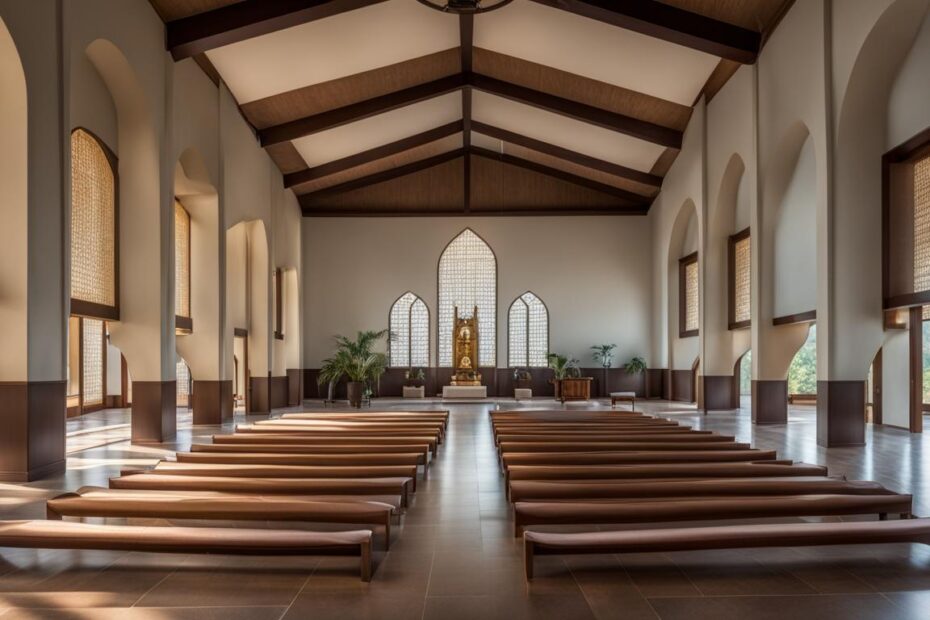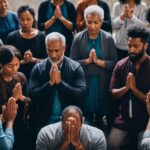Public prayer facilities, also known as prayer spaces or prayer rooms, are integral to fostering a sense of community and spiritual connection. These accessible spaces cater to various religious denominations and interfaith practices, providing a sanctuary for individuals and communities to engage in prayer and worship. In this resource guide, we will explore the different types of public prayer facilities available in the United States and provide a comprehensive overview of the services they offer.
Key Takeaways:
- Public prayer facilities provide a dedicated space for individuals and communities to engage in prayer and worship.
- These facilities cater to various religious denominations and interfaith practices.
- They offer a sanctuary for individuals to connect with their spirituality and seek solace.
- Public prayer facilities contribute to community-building and promote interfaith dialogue.
- They play a crucial role in fostering inclusivity and providing support to individuals seeking spiritual fulfillment.
Understanding the Importance of Public Prayer Facilities
Public prayer facilities play a crucial role in fostering a sense of community and strengthening spiritual connections among individuals. These spaces provide a dedicated place for people to engage in prayer and worship, regardless of their religious beliefs. They offer a safe and inclusive environment where people can find peace, solace, and support.
Public prayer facilities also contribute to the social fabric of a community by promoting interfaith dialogue and understanding. They serve as a vital resource for individuals seeking spiritual fulfillment and communal connection. By providing a space for collective prayer, these facilities facilitate community-building through shared spiritual experiences.
Research has shown that prayer has various psychological and emotional benefits. Prayer can reduce stress, improve mental well-being, and enhance feelings of connectedness. Public prayer facilities provide an accessible and dedicated space where individuals can engage in these practices, benefiting their overall well-being and sense of belonging.
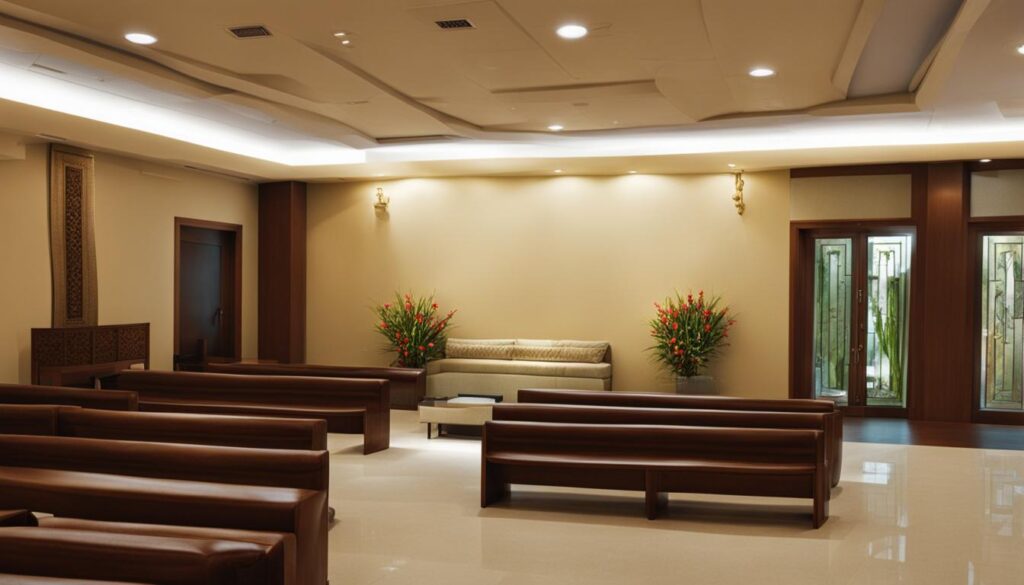
Through prayer, people can find solace and guidance, helping them navigate life’s challenges with resilience and hope. Public prayer facilities serve as a haven where individuals can seek spiritual support and draw strength from their faith. The inclusivity and welcoming nature of these spaces create an environment where people from diverse backgrounds can come together, fostering a sense of unity and understanding. This sense of community-building through prayer is essential for promoting harmony and empathy in society.
Types of Public Prayer Facilities
Public prayer facilities come in various forms to cater to the diverse needs of different religious and spiritual communities. These spaces ensure that individuals have a dedicated area for prayer and worship, regardless of their faith tradition. Let’s explore some of the common types of public prayer facilities:
1. Interfaith Prayer Areas
Interfaith prayer areas are designed to accommodate individuals from various religious backgrounds. These spaces provide a neutral environment where people of different faiths can come together for prayer and reflection. Interfaith prayer areas promote inclusivity, fostering a sense of unity among diverse communities.
2. Denomination-Specific Prayer Rooms
Denomination-specific prayer rooms cater to the needs of specific religious denominations. These rooms are tailored to align with the unique practices and beliefs of a particular faith tradition. They provide a dedicated space where individuals can engage in prayer according to their religious customs.
3. Community Prayer Spaces
Community prayer spaces are open to individuals of all faiths. These spaces aim to foster a sense of belonging and promote communal prayer and worship. Community prayer spaces often prioritize creating a welcoming and inclusive environment where individuals can gather to seek solace and connect with their spirituality.
By offering a variety of prayer facility types, communities can ensure that individuals have access to spaces that resonate with their spiritual needs and beliefs.
| Type of Public Prayer Facility | Description |
|---|---|
| Interfaith Prayer Areas | Neutral spaces accommodating individuals from various religious backgrounds |
| Denomination-Specific Prayer Rooms | Spaces tailored to specific religious denominations |
| Community Prayer Spaces | Inclusive environments open to individuals of all faiths |
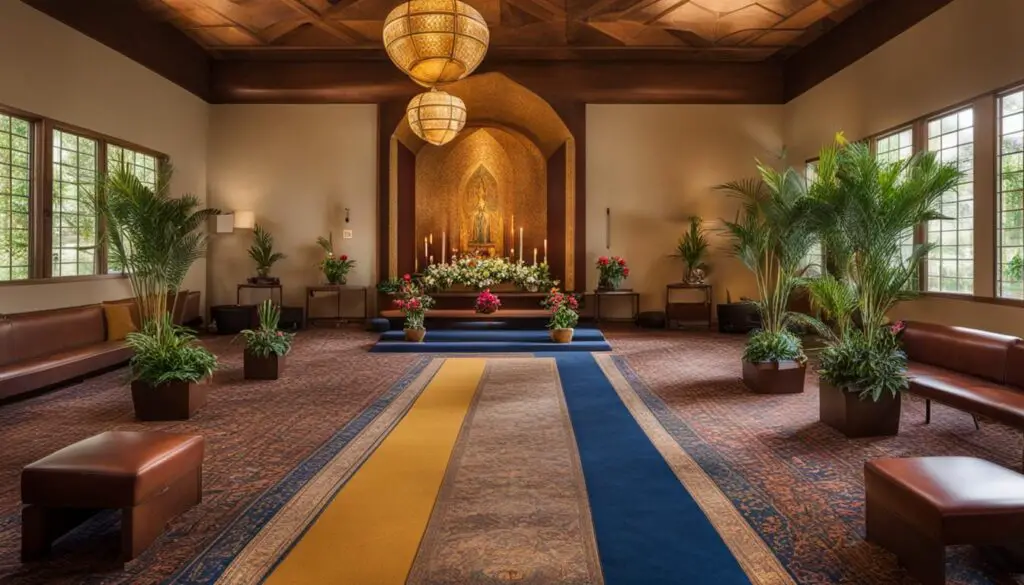
Designing and Decorating Public Prayer Facilities
Designing and decorating public prayer facilities is a crucial aspect of creating a sacred space that inspires prayer and reflection. Careful attention is given to every detail, from the layout to the decor, to foster an atmosphere of tranquility and reverence. Through intentional design choices, these prayer facilities aim to create an environment that facilitates a deep connection with the divine.
One important consideration in prayer room design is the use of lighting. Soft, warm lighting can create a calming ambiance and help individuals enter into a state of prayerful contemplation. Additionally, natural light can be incorporated through large windows or skylights, creating a connection to the outside world and allowing individuals to feel embraced by the beauty of nature as they pray.
Another key element in designing public prayer facilities is the selection of furnishings. Comfortable seating is essential to ensure that individuals can fully engage in prayer without any physical discomfort. Additionally, incorporating elements such as prayer rugs, cushions, or benches provides individuals with options that align with their unique prayer practices and preferences.
“Designing a sacred space for prayer requires thoughtfulness and intentionality. Every aspect, from the lighting to the furnishings, should contribute to creating an atmosphere that invites individuals to connect with their spirituality and enter into a deep state of prayer.”
Decorating public prayer facilities often involves incorporating artwork and decorative elements that inspire prayer. Sacred symbols and images from various religious traditions can be displayed to foster a sense of inclusivity and honor the diversity of those who utilize the prayer space. These artistic expressions can serve as visual reminders of the divine and help individuals focus their minds and hearts on prayer.
Ultimately, the goal of designing and decorating public prayer facilities is to create an environment that supports individuals in their spiritual journey and facilitates a profound experience of prayer. Through thoughtful design choices and attention to detail, these sacred spaces can inspire individuals to enter into a deeper connection with the divine.

Running and Managing Public Prayer Facilities
Effective management of public prayer facilities is crucial to ensure their smooth operation and provide a welcoming and supportive environment for individuals seeking solace and connection with their spirituality. This section explores key aspects of running and managing these prayer spaces, including organizing prayer rooms, forming prayer room teams, and maintaining prayer spaces.
Organizing Prayer Rooms
Organizing prayer rooms involves creating a structured system for individuals to access and utilize the facilities. This can include establishing a reservation or scheduling process to ensure fair and equitable distribution of prayer time among different individuals and groups. By implementing an organized system, prayer room usage can be effectively managed, and conflicts or overcrowding can be minimized. It is important to provide clear guidelines and expectations for visitors regarding appropriate conduct, dress code, and any specific customs or practices observed within the prayer facility.
Forming Prayer Room Teams
Forming dedicated prayer room teams is essential for the successful management of public prayer facilities. These teams can consist of volunteers from the community who are passionate about fostering a positive and inclusive prayer environment. Responsibilities of the prayer room teams may include overseeing the cleanliness and maintenance of the prayer spaces, monitoring visitor behavior and ensuring adherence to guidelines, and providing assistance or support to individuals who may have specific needs or questions. Regular training and communication among team members can help ensure a cohesive and effective management approach.
Maintaining Prayer Spaces
Maintaining prayer spaces involves regular upkeep and care to ensure that these facilities are clean, well-maintained, and conducive to prayer and worship. This includes regular cleaning and sanitization, ensuring the availability of necessary supplies such as prayer mats or religious texts, and addressing any maintenance issues promptly. Prayer spaces should be welcoming and comfortable, providing an atmosphere that promotes tranquility and reflection. Regular inspections and feedback from visitors can help identify areas for improvement and ensure that the prayer spaces continue to meet the needs of the community.
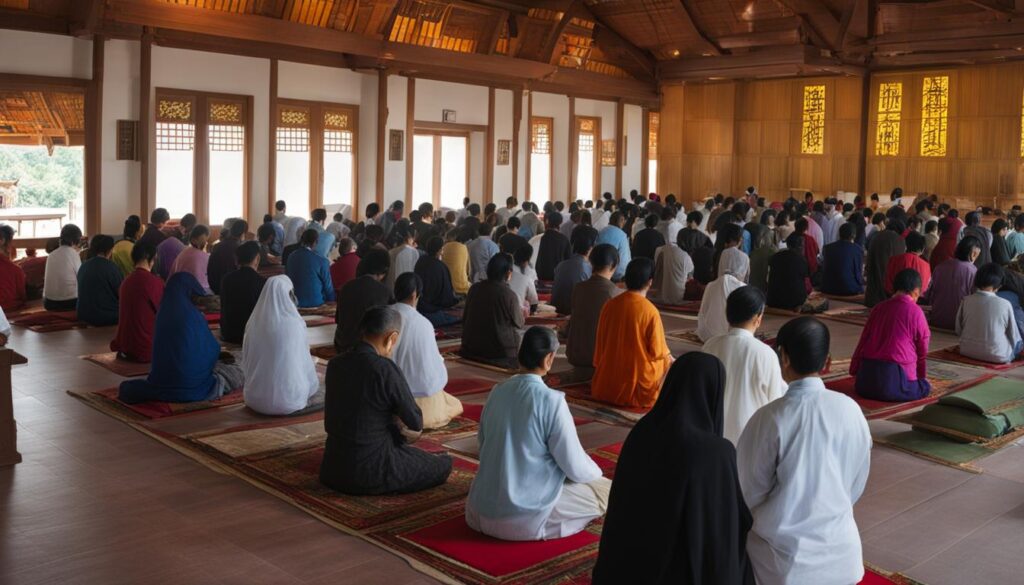
| Organizing Prayer Rooms | Forming Prayer Room Teams | Maintaining Prayer Spaces |
|---|---|---|
| Establish a structured system for individuals to access and utilize prayer rooms | Form dedicated prayer room teams consisting of community volunteers | Regular cleaning and sanitization of prayer spaces |
| Implement a reservation or scheduling process to manage prayer room usage | Oversee cleanliness and maintenance of the prayer spaces | Ensure availability of necessary supplies |
| Provide clear guidelines and expectations for visitors | Monitor visitor behavior and provide assistance or support | Promptly address maintenance issues |
Encouraging Community Participation and Involving Youth in Prayer
Public prayer facilities not only provide a sacred space for individuals to connect with their spirituality but also offer opportunities for community participation and the involvement of youth in prayer. Encouraging community engagement is crucial for fostering a vibrant and inclusive prayer community. By promoting active involvement, public prayer facilities can create a sense of ownership and belonging among community members, leading to a stronger bond and a more enriching prayer experience.
Youth involvement in prayer plays a vital role in nurturing the future generation and ensuring the continuity of spiritual practices. Public prayer facilities can organize special events and workshops tailored for youth, where they can learn about different prayer traditions, explore their own spiritual paths, and engage in meaningful discussions. By providing a space for youth to express their beliefs and experiences, public prayer facilities empower young individuals to develop their spirituality and contribute to the broader prayer community.
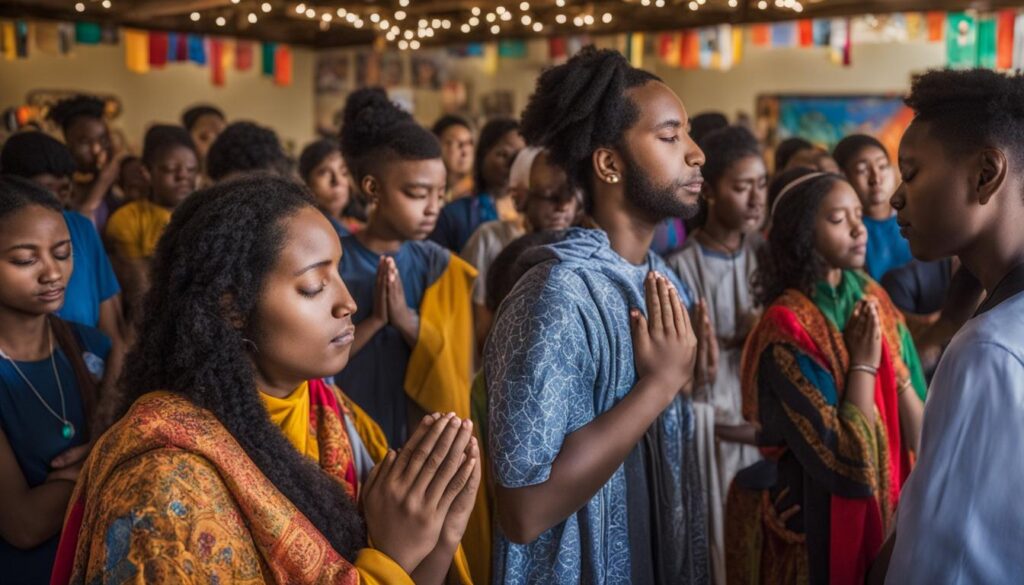
Promoting Prayer Literature to Deepen Spiritual Connection
In addition to fostering community participation and involving youth, public prayer facilities can also promote prayer literature to enhance individuals’ understanding and practice of prayer. Prayer literature provides valuable insights, guidance, and inspiration for those seeking to deepen their spiritual connection. Public prayer facilities can curate a collection of prayer books, texts, and resources that cover a wide range of spiritual traditions, allowing individuals to explore various prayer methods and perspectives.
By offering prayer literature, these facilities enable individuals to engage with prayer beyond the physical space, encouraging personal reflection and self-guided spiritual growth. Public prayer facilities may also organize book clubs or discussion groups centered around prayer literature, providing a platform for individuals to share their thoughts, insights, and experiences. This promotes a culture of continuous learning and dialogue, strengthening the prayer community and enriching the spiritual journey of individuals.
The Transformative Power of Community-Wide Prayer Initiatives
Public prayer facilities can initiate and promote community-wide prayer initiatives that bring individuals together in a shared prayer experience. These initiatives can take various forms, such as prayer gatherings, interfaith prayer services, or community-wide prayer campaigns. By organizing these events, public prayer facilities foster a sense of unity and solidarity among community members, transcending differences and promoting mutual understanding.
Community-wide prayer initiatives can also address specific societal issues or challenges, allowing individuals to come together in prayer for the well-being of their communities and the world at large. These initiatives provide a platform for collective intention and action, harnessing the transformative power of prayer to bring about positive change. Through community-wide prayer initiatives, public prayer facilities demonstrate the potential of prayer to impact not only individual lives but also the larger social fabric.
Public Prayer Facilities and Contemplative Practices
Public prayer facilities often provide opportunities for individuals to engage in contemplative practices, such as centering prayer. Centering prayer is a method of silent prayer that deepens spiritual connection and fosters a sense of inner stillness and peace. These prayer facilities may offer guidance and support in exploring various contemplative prayer methods and traditions, encouraging individuals to cultivate a deeper level of intimacy with the divine. The incorporation of silence and stillness into public prayer spaces allows for personal reflection and communion with the divine presence.
Centering prayer, also known as meditation in some traditions, is a practice rooted in ancient spiritual traditions and has gained popularity in various religious and spiritual communities. It involves sitting quietly, focusing on a sacred word or phrase, and letting go of thoughts and distractions. This practice allows individuals to quiet their minds, cultivate mindfulness, and develop a deeper awareness of their inner selves and the divine presence within.
While some public prayer facilities may specifically offer centering prayer sessions or workshops, many other facilities provide spaces conducive to contemplative practices. These spaces often feature serene environments with soft lighting, comfortable seating, and minimal distractions. Individuals visiting these facilities can retreat from the busyness of daily life and immerse themselves in a sacred atmosphere that supports their spiritual journey.
Spiritual Transformation through Prayer: Testimonies of Impact
Prayer has long been recognized as a powerful catalyst for personal and societal change, leading to profound spiritual transformations. Through the act of prayer, individuals are able to tap into their innermost self, seek divine guidance, and experience a deep connection with something greater than themselves. The transformative power of prayer has been witnessed and shared through countless testimonies, showcasing the profound impact it can have on individuals and communities alike.
Testimonies of prayer impact often highlight how prayer has brought about positive changes in various aspects of one’s life. For example, individuals may share how prayer has helped them find strength and solace during times of adversity. By surrendering their worries and concerns to a higher power, they have been able to experience a sense of peace and comfort that transcends their circumstances.
“Prayer has been my anchor in the storms of life. Through prayer, I have found the strength to overcome challenges and the courage to face my fears. It has been a transformative journey of self-discovery, where I have learned to let go and trust in a higher plan. Prayer has opened doors I never thought possible and has brought blessings beyond my imagination.”
Prayer also has the potential to ignite a sense of purpose and clarity, enabling individuals to align their actions with their spiritual values. It can provide guidance in decision-making processes, helping individuals navigate through life’s complexities with wisdom and discernment. Through prayer, individuals have found the courage to pursue their dreams, make positive changes in their lives, and contribute to the betterment of society.
The testimonies of those who have experienced the transformative power of prayer within public prayer facilities echo the same sentiments. These dedicated spaces provide a nurturing environment that fosters spiritual growth, healing, and connection. They serve as sanctuaries where individuals can come together, supporting one another in their journeys of faith. Public prayer facilities have become catalysts for transformative experiences, where individuals have witnessed and shared stories of healing, reconciliation, and personal growth.
The Power of Prayer: A Transformative Journey
Promoting Inclusivity and Fostering Interfaith Dialogue in Public Prayer Spaces
Expanding access to public prayer facilities is crucial for promoting inclusivity and fostering interfaith dialogue. By establishing prayer facilities in underserved areas, individuals from diverse backgrounds can have equal opportunities to connect with their spirituality and engage in communal prayer. These prayer spaces act as catalysts for positive social change, bringing together people from different religious communities and encouraging mutual understanding and respect.
Inclusivity in prayer spaces is essential to ensure that individuals of all faiths feel welcome and accepted. By creating an environment that embraces diversity, public prayer facilities can foster a sense of belonging and unity among worshippers. This can be achieved through the implementation of inclusive practices, such as providing resources and accommodations for different religious traditions, and promoting interfaith events and activities.
Fostering interfaith dialogue within public prayer facilities is an effective way to promote understanding and cooperation among different religious communities. By organizing interfaith events, workshops, and discussions, individuals can learn about the beliefs and practices of others, leading to increased tolerance and empathy. Interfaith dialogue also encourages individuals to explore common values and shared goals, fostering a sense of unity and collaboration in the pursuit of spiritual growth and social harmony.
Conclusion
Public prayer facilities are invaluable resources that provide individuals and communities with a dedicated space for prayer, worship, and spiritual connection. This comprehensive resource guide has explored the various types of public prayer facilities available, highlighting their significance in community-building and the transformative power of prayer. Whether interfaith or denomination-specific, these prayer spaces serve as sanctuaries for individuals seeking solace, comfort, and a sense of belonging.
By understanding and embracing the importance of public prayer facilities, individuals can deepen their spiritual journey and cultivate a stronger connection with the divine. These spaces foster inclusivity, promote interfaith dialogue, and offer opportunities for personal reflection and communion with the divine presence. Prayer has the potential to bring about transformative experiences, enabling individuals to find strength, healing, and clarity in the face of life’s challenges.
As individuals seek solace, support, and inspiration, the resource guide serves as a valuable reference for exploring and accessing public prayer facilities. Whether one is looking for an interfaith prayer area, a denomination-specific prayer room, or a community prayer space, these facilities provide the environment needed for spiritual growth and connection. Together, these prayer spaces contribute to the spiritual well-being of individuals and the social fabric of our communities, fostering understanding, unity, and a shared pursuit of spirituality.
FAQ
What are public prayer facilities?
Public prayer facilities are spaces where individuals and communities can engage in prayer and worship. They are accessible to the public and cater to various religious denominations and interfaith practices.
What is the importance of public prayer facilities?
Public prayer facilities play a crucial role in fostering a sense of community and strengthening spiritual connections among individuals. They provide a dedicated place for people to engage in prayer and worship, regardless of their religious beliefs.
What types of public prayer facilities are available?
Public prayer facilities come in various forms to cater to the diverse needs of different religious and spiritual communities. They include interfaith prayer areas, denomination-specific prayer rooms, and community prayer spaces.
How are public prayer facilities designed and decorated?
Public prayer facilities are carefully designed to create a conducive environment for prayer and worship. Elements such as soft lighting, comfortable seating, and sacred artwork are often incorporated to evoke a sense of reverence and tranquility.
How are public prayer facilities managed?
Public prayer facilities are managed by dedicated prayer room teams who oversee the operations, schedule prayer sessions, maintain cleanliness, and provide support to visitors. Regular communication, training, and community engagement are key to their successful running.
How can communities be mobilized to engage in public prayer?
Efforts can be made to involve individuals of all ages by organizing prayer events, workshops, or teachings. Sharing prayer literature and resources and engaging community leaders and influencers can also help increase community participation.
What contemplative practices are offered in public prayer facilities?
Public prayer facilities often provide opportunities for individuals to engage in contemplative practices such as centering prayer. These facilities may offer guidance and support in exploring various contemplative prayer methods and traditions.
How can public prayer facilities bring about transformative experiences?
Prayer is often seen as a catalyst for personal and societal change. Public prayer facilities provide individuals with the opportunity to find strength, healing, and clarity, enabling them to navigate life’s challenges with resilience and hope.
How can access to public prayer facilities be expanded?
Efforts can be made to establish prayer facilities in underserved areas, reaching communities that may not have easy access to such resources. Promoting inclusivity and fostering interfaith dialogue are crucial for expanding access to public prayer facilities.


